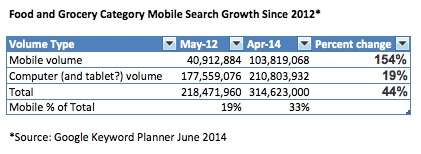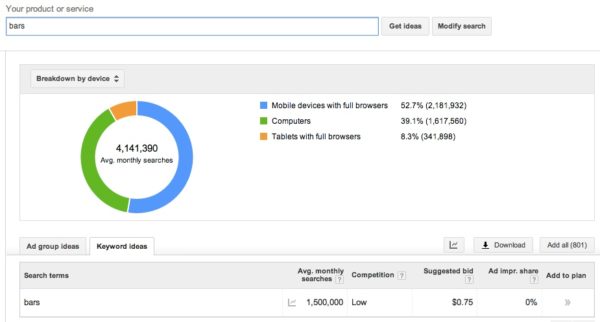3 Ways To Use Keyword Planner To Improve Your Mobile Search Visibility
Last month, we discussed what we can learn about mobile searchers from Google’s redesigned keyword planner, including that mobile searchers are often local searchers and that most of them use “near me” instead of “nearby.” This month, I want to give you three specific ways you can use the new Keyword Planner data to help […]
Last month, we discussed what we can learn about mobile searchers from Google’s redesigned keyword planner, including that mobile searchers are often local searchers and that most of them use “near me” instead of “nearby.”
This month, I want to give you three specific ways you can use the new Keyword Planner data to help your business become more visible to mobile searchers.
Data-Driven Mobile Configuration Strategy
The first thing you should do is look at your high-revenue, brand keywords to see how the majority of searchers are finding you and your competitors online. This can help you determine what mobile strategy makes the most sense for your business: responsive, adaptive, mobile-specific, or some hybrid of the three.
For example, last month we discussed how retail giants like Nordstrom overindex for tablet searches. While Google recommends responsive design in general for tablet searchers, recent research from Microsoft demonstrates that there are significant differences between tablet, smartphone and desktop searchers — enough, in fact to recommend separate interfaces and ranking for tablet search.
If you put your brand terms into the Keyword Planner and see them overindex significantly for any one device, it might be worth investing in a separate interface for tablet searchers, smartphone searchers and desktop searchers, as Google and Bing have both done.
On the other hand, if you see that your brand searches pretty clearly map to the 67.6% from computers, 26.5% from smartphones and 5.6% from tablets, numbers that we identified as the average last month, that’s a pretty clear indication that a responsive, multi-screen strategy will work pretty well for your audience.
How Mobile Savvy Is Your Audience?
Want to know how mobile savvy your category is? Or your brand searchers? Go beyond best practices and general research and let the Keyword Planner tell you.
For example, people using general terms to look for lawyers map pretty closely to the average percentages for smartphone, tablet and computer:
On the other hand, those looking for taxis and bars are twice as likely to be looking for them from smartphones as the average searcher:
What does this mean? Smart marketers might use it to give their searchers an experience that is mobile-first, using mobile-specific functionality like GPS locators to make the site truly responsive in nature.
But again, if your device breakdown maps closely to the average, maybe you can get by with a responsive site for multi-screen searchers, and not think too much about the opportunities inherent in the differences between mobile and desktop search intent.
How Fast Is Mobile Search Volume Growing?
You’ve probably seen a steady increase in smartphone and tablet searches in your analytics over the past few years. While this is great information, the problem with it is that it shows only the traffic that you get, and not the traffic that you’re missing.
With the new functionality in Keyword Planner you can start to see how fast mobile search volume is growing by accessing the Mobile Trends report.
For example, if you select the Food & Grocery category in Keyword Planner and change the dates in the Mobile Trends report you can see exactly how fast people have been adopting mobile search in that category.
It takes a little screengrabbing and manipulation in Excel to see the growth, but if you can capture the numbers in the first and last month you can see where your category is when it comes to mobile search:

You can use that data to show the C-suite the urgency in mobile search for your category.
Have you found any reports in the new Keyword Planner that have helped you improve your mobile search visibility? Feel free to share in the comments.
Contributing authors are invited to create content for MarTech and are chosen for their expertise and contribution to the search community. Our contributors work under the oversight of the editorial staff and contributions are checked for quality and relevance to our readers. MarTech is owned by Semrush. Contributor was not asked to make any direct or indirect mentions of Semrush. The opinions they express are their own.
Related stories



